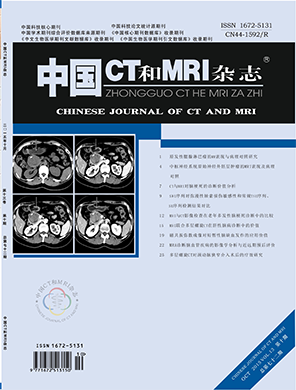摘要
目的探讨不同病理分期老年肝 纤维化患者多层CT灌注成像参数变化情 况。方法 选取医院收治肝纤维化患者65 例作为肝纤维化组,选取25例健康志愿 者作为对照组,均行64层螺旋CT肝脏灌注 扫描,记录门静脉灌注量(PVP)、肝动脉 灌注量(ALP)、肝脏灌注指数(HPI)、血容 量(BV)、血流量(BF),并与临床病理分期 行对照研究。结果 肝纤维化组PVP、BF、 BV均分别为(92.26±6.25)ml·100ml1 ·min-1、(41.09±3.55)ml·100ml1 ·min-1、(126.64±8.52)ml/L均显著低 于对照组,HPI为(23.18±2.85)%高于 对照组,具有统计学意义(P<0.05);S1 期PVP、BF、BV分别为(102.24±3.28) ml·100ml- 1·min- 1、(45.64±1.36) ml·100ml-1·min-1、(133.75±5.59) ml/L显著高于S3期、S4期,HPI为 (20.06±2.16)%显著低于S3期、S4期,差 异显著(P<0.05);S1期、S2期组间无显著 差异,不具统计学意义(P>0.05)。结论 64层CT灌注成像参数与老年肝纤维化病理 分期存在显著相关性。
Objective To investigate the changes of CT perfusion imaging parameters in elderly patients with hepatic fibrosis at different pathological stages. Methods 65 patients with hepatic fibrosis in the hospital were selected as the hepatic fibrosis group and 25 cases of healthy volunteers were selected as the control group. All of them received 64-slice spiral CT hepatic perfusion scanning. The amount of portal vein perfusion (PVP), hepatic arterial perfusion (ALP), liver perfusion index (HPI), blood volume (BV) and blood flow (BF) was recorded and was compared with clinical pathological stage. Results PVP, BF and BV of the hepatic fibrosis group were (92.26±6.25)ml·100ml-1·min-1,(41.09±3.55) ml·100ml-1·min-1 and (126.64±8.52)ml/L, respectively which were significantly lower than those of the control group while HPI (23.18±2.85)% was higher than that of the control group and the differences were statistically significant (P<0.05). At S1 stage, PVP, BF and BV were (102.24±3.28)ml·100ml-1·min-1, (45.64±1.36)ml·100ml-1·min-1 and (133.75±5.59)ml/L, respectively which were significantly higher than those at S3 and S4 stage while HPI (20.06±2.16)% was significantly lower than thatat S3 and S4 stage. The differences were significant (P<0.05). There was no significant difference between S1 and S2 stage, without statistical significance (P>0.05). Conclusion There is a significant correlation between 64-slice CT perfusion imaging parameters and the pathological stages of hepatic fibrosis in elderly patients.
【关键词】肝纤维化;病理分期;64层; CT灌注成像
【中图分类号】R322.4+7
【文献标识码】A
【DOI】10.3969/j.issn.1672-5131.2015.10.022
前言
肝纤维化是由肝脏内细胞外机制过度沉淀引起,为慢性肝炎向肝 硬化发展的中间环节。近年来,有报道指出肝纤维具有可逆性的特 点,临床可早期诊断,早期治疗,控制疾病发展[1]。以往临床常采用 CT、MRI、血管数字减影(DSA)等影像学检查,但CT、MRI无法反映血流 动力学变化;DSA能够清晰显示肝血管灌、形态变化等,但属于有创检 查,限制了应用范围。近年来,多层螺旋CT灌注成像逐渐得到开发, 为肝脏CT灌注成像扫描提供了有利条件。近年来,肝脏CT灌注CT成像 逐渐应用于肝硬化、肝癌等诊断中,而对肝纤维化的报道多集中在动 物研究,其临床应用价值还有待深入探讨。对此,本文对比肝纤维化 和对照组、不同病理分期肝纤维化患者多层CT成像灌注成像参数的差 异,以探讨其临床应用价值,现报道如下。
中国CT和MRI杂志
第13卷, 第 10 期
2017年10月

相关文章